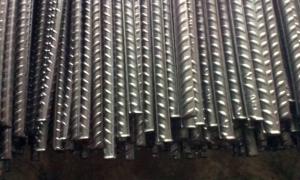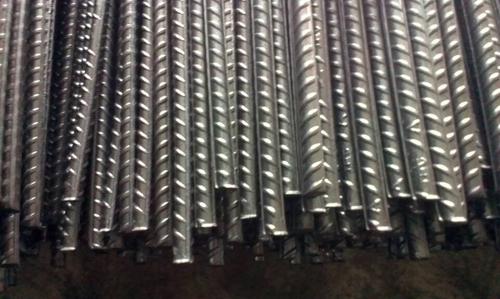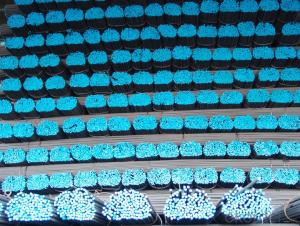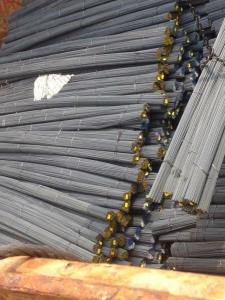Steel Cold Rolled Deformed Bar
- Loading Port:
- China Main Port
- Payment Terms:
- TT OR LC
- Min Order Qty:
- -
- Supply Capability:
- -
OKorder Service Pledge
Quality Product, Order Online Tracking, Timely Delivery
OKorder Financial Service
Credit Rating, Credit Services, Credit Purchasing
You Might Also Like
Chemical Composition: (Please kindly find our chemistry of our material based on HRB500 as below for your information)
Grade | Technical data of the original chemical composition (%) | ||||||
C | Mn | Si | S | P | V | ||
HRB400 | ≤0.25 | ≤1.60 | ≤0.80 | ≤0.045 | ≤0.045 | 0.04-0.12 | |
Physical capability | |||||||
Yield Strength (N/cm²) | Tensile Strength (N/cm²) | Elongation (%) | |||||
≥400 | ≥570 | ≥14 | |||||
Cold Rolled Techniques
Yield Point: 545-565mpa
Deformed bar is widely used in buildings, bridges, roads and other engineering construction. Big to highways, railways, bridges, culverts, tunnels, public facilities such as flood control, dam, small to housing construction, beam, column, wall and the foundation of the plate, deformed bar is an integral structure material. With the development of world economy and the vigorous development of infrastructure construction, real estate, the demand for deformed bar will be larger and larger.
- Q: What is the standard diameter of steel rebars?
- Steel rebars usually have a standard diameter that falls between 6 millimeters and 50 millimeters. The most frequently used diameters are 10 millimeters, 12 millimeters, 16 millimeters, and 20 millimeters. The choice of a particular diameter for a steel rebar depends on the specific application and the structural demands of the construction project. These rebars are commonly employed in reinforced concrete structures to bolster their tensile strength and overall endurance.
- Q: What is the average tensile strength of steel rebars?
- The average tensile strength of steel rebars typically ranges from 400 to 600 megapascals (MPa).
- Q: What is the effect of moisture on steel rebars?
- The impact of moisture on steel rebars can have significant consequences and give rise to a range of problems. Moisture has the ability to expedite the process of corrosion in steel rebars, leading to their gradual deterioration and rusting. This corrosion ultimately weakens the structural integrity of the rebars and can result in failures within concrete structures. When steel rebars come into contact with moisture, it initiates an electrochemical reaction called corrosion, whereby the water reacts with the iron in the steel. This reaction yields iron oxide, commonly known as rust, which expands and causes the rebars to crack and flake. As the corrosion progresses, the rebars gradually lose their strength, compromising the overall stability of the structure. Moisture also contributes to the development of carbonation in concrete, further heightening the risk of corrosion in steel rebars. Carbonation takes place when carbon dioxide from the atmosphere reacts with the calcium hydroxide in concrete, reducing the alkalinity of the material. This decrease in alkalinity diminishes the rebars' ability to passivate, rendering them more susceptible to corrosion. Apart from corrosion, moisture can lead to other issues such as concrete expansion, freeze-thaw damage, and efflorescence. When moisture infiltrates the concrete and subsequently freezes, it expands, causing cracks and flaking. This freeze-thaw cycle can further accelerate the corrosion process in steel rebars. On the other hand, efflorescence refers to the formation of crystalline deposits on the surface of concrete when moisture evaporates, leaving behind salts. This powdery, white substance not only detracts from the appearance of concrete structures but also serves as an indicator of potential moisture-related problems. To mitigate the adverse effects of moisture on steel rebars, several preventive measures can be implemented. These include utilizing rebars that possess resistance to corrosion, applying protective coatings or membranes to the rebars, ensuring adequate concrete cover over the rebars, and implementing effective drainage systems to prevent the accumulation of moisture. Regular inspections and maintenance are also of utmost importance in order to identify and address any moisture-related issues before they escalate and result in structural complications.
- Q: How are steel rebars used in the construction of power plants?
- Steel rebars are commonly used in the construction of power plants due to their strength and durability. These reinforced steel bars are used to provide structural support and reinforcement to various concrete elements in the power plant construction. One of the primary applications of steel rebars in power plant construction is in the construction of foundations and structural members. Power plants require strong and stable foundations to support the heavy equipment and machinery, as well as withstand the dynamic loads and vibrations. Steel rebars are embedded within the concrete foundation to enhance its structural integrity and resistance to compressive and tensile forces. In addition to foundations, steel rebars are also used in the construction of walls, columns, and beams in power plants. These elements play a crucial role in supporting the overall structure and ensuring its stability. By adding steel rebars to the concrete mix, the resulting reinforced concrete components can bear higher loads and resist cracking or deformation under stress. Furthermore, steel rebars are utilized in the construction of containment structures in nuclear power plants. These structures are designed to confine any potential release of radioactive materials in case of accidents or incidents. By incorporating steel rebars into the concrete walls and floors of these containment structures, their strength and resistance to impact and penetration are significantly enhanced, thereby improving the safety and security of the power plant. Overall, steel rebars play a vital role in the construction of power plants by providing reinforcement to concrete elements and ensuring the structural integrity and longevity of the facility. Their use enhances the strength, durability, and safety of the power plant, making it capable of withstanding various operational and environmental conditions.
- Q: The effect of adding alum on thread steel
- Vanadium can remarkably improve the weldability of ordinary low carbon low alloy steel. Vanadium is an excellent deoxidizer for steel. 0.5% of the vanadium in the steel can refine the grain and improve the strength and toughness. The carbides formed by vanadium and carbon can improve hydrogen corrosion resistance under high temperature and high pressure.
- Q: Can steel rebars be used in the construction of industrial facilities?
- Yes, steel rebars can be used in the construction of industrial facilities. Steel rebars provide strength and reinforcement to concrete structures, making them suitable for heavy-duty applications in industrial settings. These rebars are commonly used in the construction of industrial buildings, warehouses, factories, power plants, and other similar facilities to ensure the structural integrity and durability of the infrastructure.
- Q: Can steel rebars be used in marine structures?
- Marine structures can indeed utilize steel rebars. Due to its robustness, endurance, and resistance to corrosion, steel is a prevalent material in marine construction. Nonetheless, it is crucial to employ steel rebars that are specifically engineered for marine purposes. These rebars are typically manufactured from stainless steel or galvanized steel, both of which possess superior corrosion resistance properties compared to traditional carbon steel rebars. Furthermore, an additional safeguard such as epoxy coating or cathodic protection systems can be applied to further bolster the rebars' ability to withstand corrosion in harsh marine environments. Consistent maintenance and vigilant monitoring are also vital to ensure the long-term effectiveness and integrity of steel rebars in marine structures.
- Q: Can steel rebars be used in seismic-resistant structures?
- Seismic-resistant structures can indeed incorporate steel rebars. These rebars possess remarkable tensile strength and ductility, rendering them a perfect choice for reinforcing concrete structures in regions susceptible to earthquakes. By implementing them in a well-designed and properly installed manner, steel rebars significantly enhance the structural integrity and resilience of buildings against seismic forces. They furnish concrete with added strength and flexibility, enabling it to endure lateral and vertical loads exerted during an earthquake more effectively. Additionally, steel rebars proficiently disperse and absorb the energy generated during seismic events, thereby diminishing the risk of structural harm or collapse.
- Q: How are steel rebars protected against chemical attacks?
- Corrosion protection is a process that shields steel rebars from chemical attacks. Various techniques and materials are utilized to prevent corrosive substances from harming the rebar. One method commonly employed is the application of protective coatings. These coatings, such as epoxy or zinc, create a barrier on the rebar's surface, obstructing corrosive substances from reaching the steel. Moreover, these coatings offer added protection against moisture and other environmental factors that contribute to corrosion. Corrosion inhibitors are another means of safeguarding the rebars. These chemicals can be added to the concrete mix or directly applied to the rebar. By forming a protective layer on the steel's surface, corrosion inhibitors impede the corrosion process. These inhibitors can be organic or inorganic compounds, targeting specific corrosion mechanisms. In certain cases, stainless steel rebars are used to protect against chemical attacks. Stainless steel possesses greater resistance to corrosion in comparison to regular steel rebars. The presence of chromium creates a passive layer on the steel's surface, guarding it against chemical reactions. Stainless steel rebars are frequently utilized in highly corrosive environments, such as marine structures or wastewater treatment plants. Regular maintenance and inspection play a crucial role in safeguarding steel rebars against chemical attacks. Any signs of damage or corrosion should be promptly addressed. Regular cleaning and removal of corrosive substances that accumulate on the rebars also aid in preventing chemical attacks. In conclusion, a combination of protective coatings, corrosion inhibitors, stainless steel rebars, and regular maintenance is essential for protecting steel rebars against chemical attacks. These measures prolong the rebars' lifespan and uphold the structural integrity of concrete structures.
- Q: How are steel rebars protected against accidental damage during construction?
- Steel rebars are protected against accidental damage during construction through a variety of measures. One common method is to place plastic caps on the ends of the rebars to prevent them from getting damaged or bent. Additionally, rebars can be covered with plastic or foam sleeves to provide an added layer of protection. Construction workers are also trained to handle rebars carefully and avoid any activities that may cause accidental damage.
Send your message to us
Steel Cold Rolled Deformed Bar
- Loading Port:
- China Main Port
- Payment Terms:
- TT OR LC
- Min Order Qty:
- -
- Supply Capability:
- -
OKorder Service Pledge
Quality Product, Order Online Tracking, Timely Delivery
OKorder Financial Service
Credit Rating, Credit Services, Credit Purchasing
Similar products
Hot products
Hot Searches
Related keywords























